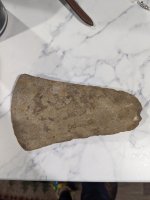Jess122604
Newbie
I found this as part of a collection, unfortunately at an antique store so I have no idea where they were first found. The owner said they were bought in the Oklahoma City area at an estate sale. I have no real knowledge as to whether this is real or a reproduction, but I have been reading and trying to learn. Maybe it's a cultivation tool, like a hoe? Would value opinions.








Amazon Forum Fav 👍
Attachments
Upvote
6





